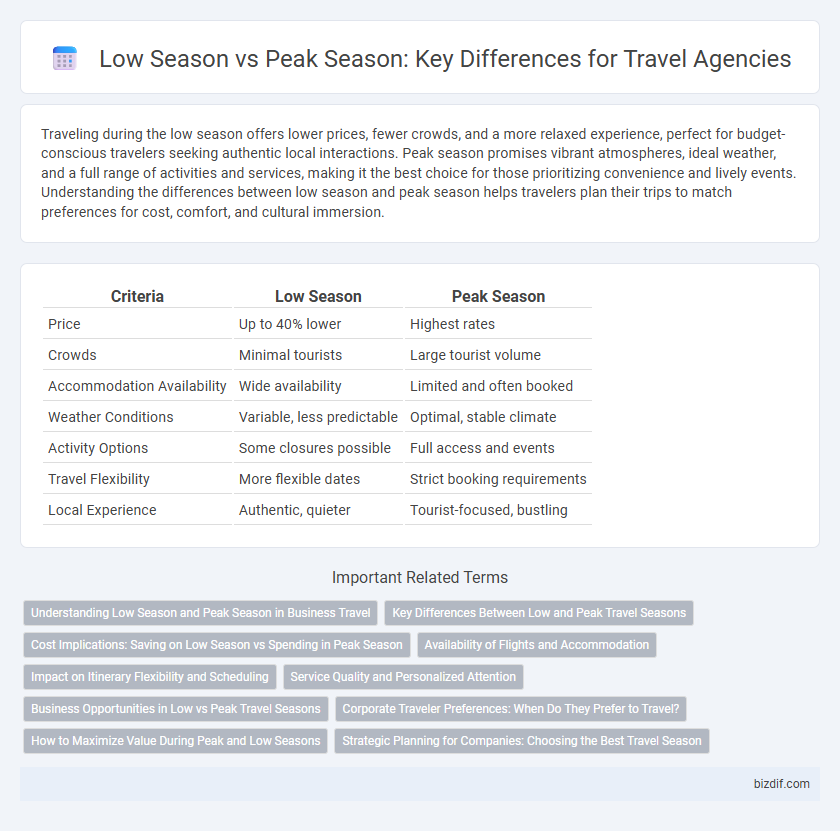Traveling during the low season offers lower prices, fewer crowds, and a more relaxed experience, perfect for budget-conscious travelers seeking authentic local interactions. Peak season promises vibrant atmospheres, ideal weather, and a full range of activities and services, making it the best choice for those prioritizing convenience and lively events. Understanding the differences between low season and peak season helps travelers plan their trips to match preferences for cost, comfort, and cultural immersion.
Table of Comparison
| Criteria | Low Season | Peak Season |
|---|---|---|
| Price | Up to 40% lower | Highest rates |
| Crowds | Minimal tourists | Large tourist volume |
| Accommodation Availability | Wide availability | Limited and often booked |
| Weather Conditions | Variable, less predictable | Optimal, stable climate |
| Activity Options | Some closures possible | Full access and events |
| Travel Flexibility | More flexible dates | Strict booking requirements |
| Local Experience | Authentic, quieter | Tourist-focused, bustling |
Understanding Low Season and Peak Season in Business Travel
Low season in business travel typically occurs during periods of reduced demand, often resulting in lower rates for flights, accommodations, and meeting venues. Peak season coincides with key industry events, conferences, and holidays, driving higher prices and increased competition for travel resources. Understanding these seasonal fluctuations enables travel agencies to optimize booking strategies and offer cost-effective solutions for corporate clients.
Key Differences Between Low and Peak Travel Seasons
Low season travel typically offers lower prices, fewer crowds, and more personalized experiences due to decreased demand, while peak season sees higher costs, increased tourist density, and greater availability of events and attractions. Accommodation and flight prices can surge by up to 50-70% during peak season, contrasting sharply with budget-friendly options available in the low season. Weather variations also play a critical role, as peak season often coincides with optimal climate conditions, whereas low season may involve off-peak weather challenges.
Cost Implications: Saving on Low Season vs Spending in Peak Season
Travelers benefit from significantly lower prices on accommodations, flights, and tours during the low season, with savings often reaching 30-50% compared to peak season rates. Peak season travel incurs higher costs due to increased demand, including inflated hotel rates and expensive airfare, which can strain travel budgets. Strategic planning around low season travel allows budget-conscious tourists to enjoy destinations with fewer crowds and reduced expenses.
Availability of Flights and Accommodation
Flight availability during low season is significantly higher, allowing travelers greater flexibility in choosing dates and destinations without facing overbooked flights. Accommodation options multiply with lower occupancy rates, often resulting in better deals, a wider selection of rooms, and personalized services from hotels and resorts. Peak season experiences limited flight seats and crowded hotels, driving prices up and reducing booking options for last-minute travelers or those seeking premium accommodations.
Impact on Itinerary Flexibility and Scheduling
Low season travel offers greater itinerary flexibility and easier scheduling due to fewer crowds and more available accommodations. Peak season limits options as high demand leads to fully booked tours and stricter timetables, requiring early reservations. Travelers benefit from low season by customizing activities without time constraints, while peak season often involves fixed schedules and less spontaneous changes.
Service Quality and Personalized Attention
Low season travel offers enhanced service quality and more personalized attention due to lower customer volume, allowing agencies to focus on individual preferences and tailor experiences precisely. During peak season, high demand often leads to standardized services and limited customization, as agencies manage large groups and stricter schedules. Choosing low season travel ensures better access to knowledgeable agents and more flexible itineraries, improving overall satisfaction and value.
Business Opportunities in Low vs Peak Travel Seasons
Low travel seasons present unique business opportunities such as discounted rates, less competition, and enhanced customer loyalty through personalized services. Peak seasons drive higher revenue due to increased demand and premium pricing but require efficient resource management to maximize profitability. Travel agencies can strategically balance these periods by offering exclusive deals during low seasons and tailored packages amid peak demand.
Corporate Traveler Preferences: When Do They Prefer to Travel?
Corporate travelers tend to prefer the low season for business trips due to lower costs, less crowded airports, and increased availability of accommodations. Peak season travel is often avoided unless aligned with industry conferences or critical meetings, as higher prices and limited options can disrupt tightly scheduled agendas. Understanding these preferences helps travel agencies tailor corporate travel packages to optimize budget and efficiency.
How to Maximize Value During Peak and Low Seasons
Maximizing value during peak and low travel seasons involves strategic planning and savvy booking choices. During peak season, securing accommodations and flights early ensures availability and better rates despite higher demand. In contrast, low season offers significant discounts and less crowded attractions, ideal for budget travelers seeking high value without compromising experience quality.
Strategic Planning for Companies: Choosing the Best Travel Season
Strategic planning for travel agencies involves analyzing low season and peak season dynamics to maximize profitability and customer satisfaction. During low season, companies can leverage reduced competition and lower operational costs to attract budget-conscious travelers through targeted promotions. Peak season demands efficient resource allocation and premium pricing strategies to capitalize on high demand while maintaining service quality.
Low Season vs Peak Season Infographic

 bizdif.com
bizdif.com